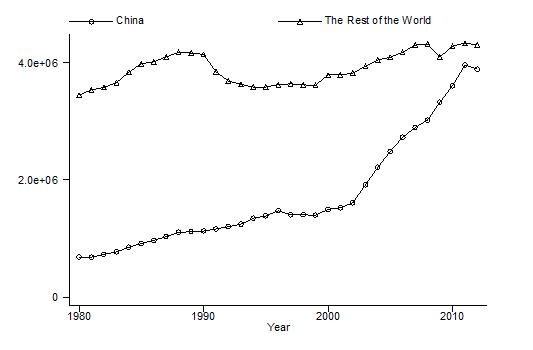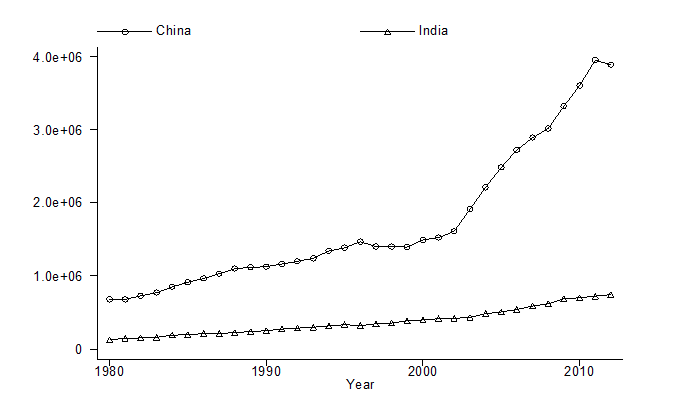Will China Reduce Coal Consumption and Greenhouse Gas Emissions?

China features some of the world’s most polluted cities. In recent years, it has become the world’s leading producer of greenhouse gas emissions. The major cause of this pollution has been burning coal.
Figure 1 compares China’s annual consumption from 1980 until 2012 with the rest of the world’s consumption. In the early 1980s, the gap between China and the rest of the world was huge but in recent years the gap has sharply narrowed.

Data Source: https://www.eia.gov/cfapps/ipdbproject/IEDIndex3.cfm?tid=1&pid=1&aid=2
During the year 2001 to 2012 as China’s economy grew by over 10% per year, its coal consumption sharply accelerated. This coal was used to generate electricity used by industry and to provide families with winter heat.
Figure 2 compares China’s annual coal consumption versus India’s annual consumption. While India is a fast growing nation, a divergence in their respective coal consumption is clearly visible.

Data Source: https://www.eia.gov/cfapps/ipdbproject/IEDIndex3.cfm?tid=1&pid=1&aid=2
In 2016, almost everyone in China has access to electricity while in India, roughly 80% of the population has access to electricity. All developing countries face the tradeoff of increasing access to electricity while simultaneously seeking to reduce their greenhouse gas emissions.
In the case of China, its coal intensive development has meant that poor coal miners earned good wages producing coal that was used by heavy industry that produced goods mainly for export to nations such as the United States. As the world’s factory, “Made in China” has become a ubiquitous label on durable products. While urbanization and industrialization sharply reduced China’s poverty and created many rich industrial fortunes, a byproduct of this production has been pollution of the air, water, food supply, natural capital degradation, and a huge increase in greenhouse gas emissions.
An Economic Analysis of Key Energy Tradeoffs in China
China’s Communist Party (CCP) leaders now face a key tradeoff. They seek to reduce the local and global pollution consequences of growth while continuing to enjoy robust macroeconomic progress. At the COP 21 Meeting in Paris in December 2015, China promised that its greenhouse gas emissions would peak in 2030 and that its carbon intensity (emissions per dollar of GDP) would decline to 60% of its 2005 level by the year 2030. By way of comparison, the United State’s carbon intensity has declined by 60% from 1960 to 2011. Can China achieve in fifteen years a goal that took the United States 51 years?
While there are many possible ways to achieve these stated goals, it is highly likely that meeting this goal will require burning less coal by moving away from coal fired power generation (coal now accounts for roughly 75% of the fuel used for power generation) to natural gas and renewable power generation. Unlike the United States, China is now building more nuclear power plants. Mainland China has 32 nuclear power reactors in operation, 22 under construction, and more to break ground.
The count of vehicles in China has increased from 26 million in 2004 to 146 million in 2014.1 At a time of such rapid motorization, sharp reductions in greenhouse gas emissions will require a huge increase in vehicle fuel economy. This can partially be achieved by the rise of electric vehicle adoption if these vehicles are powered by clean power. A recent U.S study documented that electric vehicles can emit more carbon than conventional vehicles if the power is generated by coal fired power plants.2 This means that driving a Prius in California creates much less greenhouse gas emissions than driving such a Prius in Ohio where the power is generated using coal.
At the global level, continuing innovation is improving solar panel and electric vehicle technologies. It remains an open question, however, whether these costs can fall fast enough to allow China to achieve its stated goal.
For a nation endowed with ample coal, it may be surprising that China claims to be actively pursuing this green agenda. In my recent 2016 book; Blue Skies Over Beijing (co-authored with Siqi Zheng of Tsinghua University), we argue that there is a growing set of educated Chinese urbanites who demand a better quality of life for themselves and their family. An emerging environmental economics literature documents that a cleaner environment improves one’s day-to-day life, increases children’s health, and enhances worker productivity.3 While the people of China do not directly vote in elections, these urbanites are using social media such as Weibo (a Chinese version of Twitter) to express their concern and desire for environmental progress. In richer, more educated cities, mayors have strong incentives to deliver on such quality of life progress. In a 2014 paper, we documented that mayors in Chinese cities were more likely to be promoted if air quality is improving in their city and if the city’s industrial energy efficiency is improving.4
While China’s central government has made an increased effort to reduce the pollution from dirty energy sources, it also faces countervailing challenges. In recent months, China’s economy has slowed down. China’s economy features a mix of private companies and state owned companies (SOEs). Academic economists have argued that China’s growth would accelerate if the SOE’s share of the economy shrinks5. The Chinese leadership has prepared for a mass-downsizing of this nation’s bloated state-owned industries by laying off more than 1.8 million steel and coal workers. Reducing steel production and coal mining activity would improve environmental quality, but the affected workers are now protesting. According to China Labor Bulletin (CLB), there were more than 1,300 protests in 2014 and the number rose to over 2,700—more than one a day in Guangdong Province—in 2015. This trend has continued into 2016
The Chinese Central Government is worried that the rise of political consciousness among the working class could threaten political stability. Facing this risk, the CCP is now debating reversing the downsizing of the bloated heavy industries by again investing in and shifting resources to those industries. For example, the coal workers in Heilongjiang province took to the streets to protest against the state-run Longmay Mining Group’s decision to lay off more than 100 thousand workers in March 2016. The protests forced the provincial governor to issue a statement promising “financial support” for the firm to preserve the jobs. Such new investments could have a “lock in” effect, slowing down the Chinese economy’s transition to the green economy.
Research and Innovation
At the same time that China continues to be a major coal consumer, this huge nation is heavily investing in building up the research capacity of its major universities. Endogenous innovation opens up the possibility of “game changing” technology, decoupling greenhouse gas production from economic activity. A literature in medical economics has documented that drug companies are more likely to engage in costly and risky basic research when there is larger market demand for such a breakthrough.6 This same optimistic idea applies in the case of green technology.
At the global COP 21 conference in Paris in December 2015, the world’s nations agreed to each individually seek to reduce their greenhouse gas emissions to reduce the threat of climate change. Such a treaty acts a coordination device. Major research hubs such as China are now aware that the world’s nations demand cleaner technology. This creates a potentially very profitable new export market for China if China can carve out a niche in producing high quality affordable solar panels, wind turbines, and electric vehicles. China and India for example, are rising as major exporters of renewable power equipment to the United States.7 While the popular media highlights the challenges that China’s sheer size and economic growth poses to the global sustainability challenges, the flip side is that China’s size and accumulation of human capital raises the possibility of large breakthroughs.
Labor Market Opportunities for the Green Economy
This example highlights a fundamental tension in modern China that resembles the “1% versus the 99%” income inequality challenge in the United States. The highly educated in Beijing and Shanghai and other Chinese coastal cities seek significant environmental progress both to improve their quality of life but also to protect their children’s health. Such educated individuals are unlikely to have their employment prospects affected by environmental taxes and regulation. This suggests that the pursuit of the “green agenda” will increase quality of life inequality in both nations.
In the case of the United States, those who live in the suburbs and work in fossil fuel intensive industries are most likely to lose from the introduction of carbon pricing. In my work with Matthew Holian, I have documented that California voters are aware of this.8 California features a type of direct democracy in which its voters can vote on propositions. If these propositions receive more than 50% of the vote then they become law.
In 2010, California voters voted on Proposition 23, which sought to repeal the state’s nascent carbon dioxide cap and trade program (called AB32). Using precinct level data, we documented that suburban voters tended to vote against cap and trade. Republicans are more likely to live in the suburbs and this group tends to oppose carbon pricing. Voting precincts further from California city centers were also more likely to vote against carbon pricing.
We explain this fact by noting that suburbanites have a larger carbon footprint than central city residents, because they drive more and live in larger homes that require more electricity.9 It is true that suburban households are more likely to have solar panels but only a small percentage do. Due to current limitations in battery storage technology such solar panels do not easily recharge EV vehicles if such vehicles are used to commute during the day.
Due to the compactness of China’s cities where almost everyone lives in apartment towers and most people continue to rely on public transit, this differential in support for carbon incentives is less likely to be as pronounced as in the United States. The large difference in support for carbon mitigation is likely to be across cities where the richer, more educated coastal cities will support the green agenda while the industrialized, poorer Western cities will view carbon pricing as a threat to their city’s core comparative advantage.
Both the United States and China are wrestling with the issue of how to enjoy the gains from environmental progress while shielding the “losers” from making this transition to the green economy. Past work in labor economics has documented that manufacturing workers suffer a large wage loss when they are displaced and move into low-skill service jobs (Neal 1995). In pursuing the mutually beneficial goal of mitigating climate change risk, both nations cannot ignore how their respective carbon mitigation policies impact income inequality. Voters and interest groups are aware of “who wins and who loses” and their interests affect the domestic politics concerning which nations will abide by their promises to clean up their pollution from energy use.
Matthew Kahn
Provost Professor of Economics and Spatial Sciences, USCMatthew Kahn is the Provost Professor of Economics and Spatial Sciences at the University of Southern California. In 2015-2016 he was a visiting scholar at the Kleinman Center.
Feature Graphic: Coal Consuming China by Han Jun Zeng via Creative Commons
Glaeser, Edward L. & Kahn, Matthew E., 2010. “The greenness of cities: Carbon dioxide emissions and urban development,” Journal of Urban Economics, Elsevier, vol. 67(3), pages 404-418, May.
Matthew E. Kahn, 2000. “The environmental impact of suburbanization,” Journal of Policy Analysis and Management, John Wiley & Sons, Ltd., vol. 19(4), pages 569-586.
- National Bureau of Statistics of China. Amount of vehicles in China from 2004 to 2014 (in millions). http://www.statista.com/statistics/278422/amount-of-vehicles-in-china/ (accessed June 22, 2016). [↩]
- Holland SP, Mansur ET, Muller NZ, Yates AJ. Environmental benefits from driving electric vehicles?. National Bureau of Economic Research; 2015 Jun 18. [↩]
- Graff Zivin, Joshua and Matthew Neidell. 2013. “Environment, Health, and Human Capital.” Journal of Economic Literature, 51(3): 689-730. [↩]
- Zheng S, Kahn ME, Sun W, Luo D. Incentives for China’s urban mayors to mitigate pollution externalities: The role of the central government and public environmentalism. Regional Science and Urban Economics. 2014 Jul 31;47:61-71. [↩]
- Chang-Tai Hsieh & Peter J. Klenow, 2009. “Misallocation and Manufacturing TFP in China and India,” The Quarterly Journal of Economics, Oxford University Press, vol. 124(4), pages 1403-1448. [↩]
- Daron Acemoglu & Joshua Linn, 2004. “Market Size in Innovation: Theory and Evidence from the Pharmaceutical Industry,” The Quarterly Journal of Economics, Oxford University Press, vol. 119(3), pages 1049-1090. [↩]
- Sawhney A, Kahn ME. Understanding cross-national trends in high-tech renewable power equipment exports to the United States. Energy Policy. 2012 Jul 31;46:308-18. [↩]
- Matthew J. Holian & Matthew E. Kahn, 2015. “Household Demand for Low Carbon Policies: Evidence from California,” Journal of the Association of Environmental and Resource Economists, University of Chicago Press, vol. 2(2), pages 205 – 234. [↩]
- Matthew J. Holian & Matthew E. Kahn, 2015. “Household Demand for Low Carbon Policies: Evidence from California,” Journal of the Association of Environmental and Resource Economists, University of Chicago Press, vol. 2(2), pages 205 – 234. [↩]

